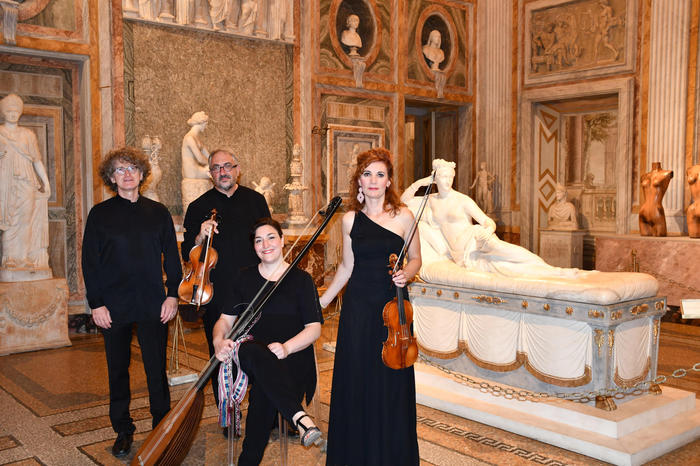The Borghese Gallery continues the research project "I Borghese e la Musica", started last December, with the second baroque concert entitled Musica in Galleria. Roman instrumental music of the seventeenth century, which is broadcast on Thursday 29 July at 7.00 pm on the website www.galleriaboriferi.beniculturali.it and the museum's official social channels and on www.ansa.it as part of the ANSA project for Culture.
Saturday 9 October at 5.30 pm the concert will also be hosted in the "Dal Vivo" program of Rai Radio 3 Classica.
With the project "I Borghese e la Musica", whose artistic direction is entrusted to Riccardo Martinini, the Gallery thus enriches its art collection also through the enhancement and dissemination of works byhuge Italian musical heritage.
The Baroque Concerto, performed by Enrico Gatti and the Aurora Ensemble, focuses on three composers who were well known in the Roman area during the seventeenth century: Arcangelo Corelli (1653-1713), destined to become the absolute protagonist of instrumental music in Baroque Rome, he achieved world fame for being able to propose unmatched models of harmonic perfection and compositional synthesis; Lelio Colista (1629-1680), and Carlo Mannelli (1640 - 1697), composers belonging to previous generations, who developed their instrumental language by balancing it with that of a vocal nature, of which some works are performed for the first time in modern times.
In the Rome of the second half of the seventeenth century numerous performances of instrumental and vocal music resound in the halls of the sumptuous cardinal palaces of the city, in the churches and oratories, in the spectacular squares which, like 'natural' theatrical spaces, welcome the many pilgrims who arrived in the city to the occasion.
Among the works in the first performance are the Sonatas a tre by Carlo Mannelli, whose manuscripts are kept at the International Music Museum in Bologna, which are characterized by a decidedly virtuosic violin writing. Born in Rome in 1640, from a family of Pistoian origins, Mannelli, often mentioned in the sources with the nickname "Carluccio" or "Carlo del violino", began very young as a singer in San Luigi dei Francesi in 1650, and then trained as a violinist ( unfortunately unknown are his masters) and become one of the most appreciated virtuosos of the city, together with Lonati, Stradella and, the oldest, Lelio Colista. With the latter he had the opportunity to play on many occasions and for the most illustrious Roman patrons. Already since 1671 in the service of the Borghese family,in 1674 the name of Mannelli appears, right next to that of Colista, in the lists of instrumentalists called to perform an oratorio for Holy Week in the chapel of the palace of Prince Giovan Battista Borghese, just as we still find the names of the two instrumentalists on the occasion of a comedy with prologues and intermediates in music always represented in Palazzo Borghese for the carnival of 1678.
The lutenist and composer Lelio Colista (1629-1680), whose works profoundly influenced the maturation of the Corellian style, was a composer particularly devoted to the genre of the sonata a tre, "famous player of lute and guitar" and "composer of beautiful symphonies" , as the composer and theorist Giuseppe Ottavio Pitoni noted, and was able to represent in the eyes of the young Corelli, who had just arrived in Rome, a model to look towards. From an early age crowned by Athanasius Kircher as "true Romanae Urbis Orpheus" (Musurgia Universalis, I, Rome 1650, p. 480), Colista was at the service of the most important Roman families (Barberini, Chigi, Borghese, Odescalchi) and reached of his career a considerable fame as an instrumentalist, composer and teacher.
The Aurora Ensemble was founded in 1986 by Enrico Gatti with the aim of creating an instrumental group that sought a new concept of sound emission based on the imitation of the human voice, using period instruments and having a long preparation work behind it. historical and musical. In addition to participation in numerous international festivals and concert seasons, the ensemble has several dozen recordings to its credit that have been repeatedly awarded by specialized critics with the Diapason d'or, the Vivaldi Prize, Choc de la Musique, Scelta di Amadeus , Preis der Deutschen Schallplattenkritik and others. (HANDLE).

